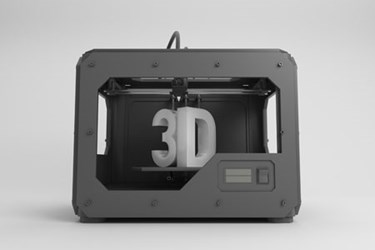3D-Printing Method Uses Multiple Materials At Once, Expands Personalized Medicine Options

Researchers from Dresden have introduced additive manufacturing (AM) technology that can work with multiple materials at the same time, giving greater design flexibility to the 3D printing process. Their technique — which can work with any combination of plastic, glass, ceramics, or metal — would allow for the quicker production of more complex and personalized bone implants, dentures, or surgical tools.
Tassilo Moritz, leader of a team at the Fraunhofer Institute for Ceramic Technologies and Systems (IKTS), believes that device developers could achieve the best of multiple worlds by incorporating strengths of multiple materials into separate components of the same 3D-printed device, according to a press release.
As an example, Moritz described an endoscope, frequently used in minimally invasive surgery both to create an incision and to quickly cauterize blood vessels using an electric current. These instruments require high-performance steel and an effective insulator — such as ceramics — to avoid shocking the patient.
Right now, these components are manufactured separately and assembled into surgical instruments, which contain crevices that are difficult to clean. But what if the tool could be 3D printed all at once using separate materials in the same process?
Moritz’s technique, which his team will present at the Medtec conference in Stuttgart this week, relies on “preparing optimum ceramic or metallic suspensions” using a thermoplastic binder that becomes liquid at 80 degrees Celsius. Because each suspension can cool down quickly, layers can be deposited in a specific sequence and different materials can be layered at the same time using multiple application units.
“We have no limitations in terms of type or color of material for the target components. This allows us to process ceramics, glass, plastic, or even metal using thermoplastic 3D printing,” said Moritz. “One more advantage is that several different materials can be produced at the same time.”
One challenge to this process, said Moritz, is the tendency of different suspensions to behave differently during sintering, but his team hopes to combat possible defects by perfecting their specialized grinding process with the different powdered materials.
Moritz’s process is part of a three-year, European Union-funded project called CerAMfacturing, which seeks to develop AM methods for medical products using ceramic and multi-material components. After achieving initial success in the lab, Moritz’s team is looking to partner with medtech developers to collaborate on a real-world application for the technology.
Currently, only $11 million of the $700 million 3D-printing industry is spent on medical applications, but projections suggest that the industry is set to move into the billions within the next ten years, and medical applications will comprise a quarter of this business, said analysts with Tata Consultancy Services (TCS) in a white paper.
Crystal Morrison, research manager in industrial coatings at PPG Industries, recently argued that the viability of AM technology in the production of medical devices will depend on innovative materials science and the understanding that biocompatible materials used with other manufacturing methods may not achieve the same quality with AM methods.
“Mechanical testing and biocompatibility questions may arise with medical devices produced using additive manufacturing,” said TCS analysts. “Additional research on improving material characteristics and manufacturing methods related to 3D printing needs to be carried out to overcome these challenges.”
